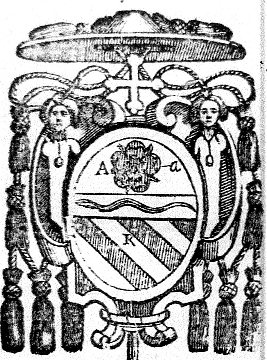
Giovanni Battista Guarini was an Italian poet, dramatist, and diplomat.

Giovanni Battista Castello was an Italian historical painter.

Giles Antonini commonly referred to as Giles of Viterbo, was a 16th-century Italian Augustinian friar, bishop of Viterbo and cardinal, a reforming theologian, orator, humanist and poet. He was born in Viterbo and died in Rome.

Carlo Giuseppe Imbonati was a Cistercian scholar who was active during the last half of the 17th century. He spent much of his career in Rome and rose to the title of abbot. He was a theologian and a Hebrew scholar who wrote prolifically in his fields. The last known references to the man are dated in 1696.
Giulio Bartolocci was an Italian Cistercian Hebrew scholar and author of the four-volume Bibliotheca Magna Rabbinica.
Felix Pratensis was an Italian Sephardic Jewish scholar who converted to the Catholic Church. He is known for his collaboration with the Flemish printer Daniel Bomberg on the first printed Hebrew Biblia Rabbinica (Veneta) of 1517/8.
Giovanni Stefano Menochio was an Italian Jesuit biblical scholar.
The Rambler was a Catholic periodical founded by liberal converts to Catholicism and closely associated with the names of Lord Acton, Richard Simpson and, for a brief period, John Henry Newman. It was one of the leading English Catholic magazines of the nineteenth century.

Giovanni Battista de Luca was an Italian jurist and Cardinal of the Roman Catholic Church. He is considered one of the most important and influential jurists of 17th-century Europe.
Raffaele Garrucci was a historian of Christian art.
Giuseppe Marchi was an Italian Jesuit archæologist who worked on the Catacombs of Rome.
Johannes Baptist Franzelin was an Austrian Jesuit theologian and Cardinal.

Giovanni Battista Tolomei, S.J., was an Italian Jesuit priest, theologian, and cardinal.
James Spencer Northcote was an English Catholic priest and writer. He served as president of St Mary's College, Oscott for seventeen years.
Giovanni Battista Casali was an Italian musician.
Domenico Gerosolimitano, originally Rabbi Samuel Vivas of Jerusalem, was a notable ecclesiastical censor of Hebrew books. His Sefer Hazikkuk, the Hebrew equivalent of Index Expurgatorius, played an important role in the censorship of Hebrew books in the late 16th and early 17th centuries.
Bible translations into Hebrew primarily refers to translations of the New Testament of the Christian Bible into the Hebrew language, from the original Koine Greek or an intermediate translation. There is less need to translate the Jewish Tanakh from the Original Biblical Hebrew, because it is closely intelligible to Modern Hebrew speakers. There are more translations of the small number of Tanakhas passages preserved in the more distantly related biblical Aramaic language. There are also Hebrew translations of Biblical apocrypha.

Giambattista Orsini was an Italian Roman Catholic cardinal. He served as papal legate to the Marches of Ancona.
Giovanni Battista Eliano was a Jesuit priest and scholar of Oriental languages.






